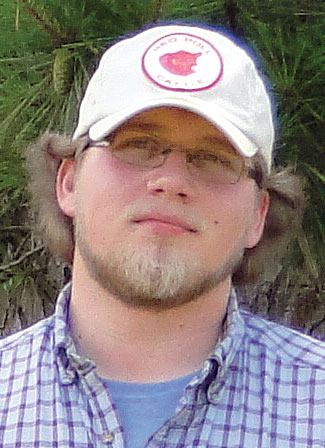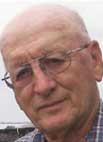
Sometimes family circumstances open unforeseen possibilities.
Caleb Cunningham of Booneville, Ark., is one such farmer. Caleb’s grandfather, Douglas, owns the farm though he and his wife Peggy, as well as Caleb’s other grandmother, Dorothy Thacker, require substantial daily assistance.
Caleb’s father and mother, Randy and Susan, resigned from the church where Randy pastored to provide that care. That left farm management predominantly to Caleb.
Caleb, 23, earned a degree from Arkansas State University in animal science and wanted to pursue a career in veterinary medicine, but decided to go into finance instead. One reason was because he wanted to stay in the area, and the family situation also offered the opportunity to pursue his love of farming.
Caleb’s off-the-farm job is with the U.S. Department of Agriculture, making Farm Service Agency farm loans in six counties, working both in the office and on-site. He leaves at 6 a.m. for work, after feeding the hogs and letting the sheep out.
The Cunningham operation involves 500 acres, 200 of which were wooded, but are now cleared though not clean with two years of regrowth needing to be removed.
What makes the Cunningham operation unique is a holistic management system presented by Zimbabwean Allen Savory in the 1970s.
“I consider the full impact of each decision when making decisions whether about land management, breeding choices or stock varieties,” Caleb said.
Simply put, his holistic method uses several species grazing intensively in a specific order on land predominantly composed of natural grasses though the Cunningham land is still under development.
The animals are supported by minerals, which are changed according to the season, and the hogs and chickens are fed non-GMO grain. Caleb will reseed with a cool season mix for winter grazing. He is developing land with big and little Bluestem, switchgrass, Indian grass, volunteer rye, and naturally returning clovers providing varying root depths, nutrition, and species preference.
The Cunninghams also buy all their hay.
“This is outside the mainstream, but continual haying of the same meadow is damaging to soil health and causes the soil to retain less water,” Caleb said.
This year, Caleb purchased 100 bales of Bermuda and 200 bales of mixed pasture hay.
The species order typically involves cattle first, then sheep followed by chickens, which can be followed by swine. Intensive rotational grazing for Caleb means being able to graze 75 head of cattle on one-quarter acre by moving them twice per day under good growth and weather conditions. Currently the Cunninghams’ free range pigs are not in the rotation, rather helping to clear the scrubland, a perfect environment for their heritage Durocs. The rotation disrupts the parasite lifecycle.
“If I have to worm something, it leaves the farm,” Caleb said.
Sheep prefer different plants than cows and consume cattle parasites, while the chickens scratch through the manure, eating more parasites and breaking up both the manure and the fly cycle. The process fertilizes the ground more readily, while livestock urine lowers soil acidity. The goal is for animal impact to build organic matter, soil microbes, and soil fertility which minimizes the need for human intervention.
The Cunninghams have 40 commercial Brangus and 35 registered Red Polls.
The Red Poll is an old English breed that was initially dual-purpose. They retain high milking productivity, but are seldom use for dairy anymore but rather as a meat animal because breeding preferences for show cattle disrupted the balance. Caleb searches out hidden herds with the old bloodlines he wants to preserve so that cows retain milking functionality and are effective mommas that marble naturally, even when grass fed. He found one such herd in Alabama belonging to T.J. Currier.
“I utilize line and in-breeding in order to gain predictability and functionality in my stock,” Caleb explained. “My approach to stock breeding does not focus on single trait selection, but seeks well-rounded animals, such as the original Red Poll bloodlines.”
Caleb has May calves, weaning and selling calves at 6 to 7 months of age, when the calves weigh about 500 pounds. Potential breeding stock are left to wean naturally as part of building and refining his herd.
“The goal is to optimize not maximize profits,” he explained. “In terms of selecting heifers, I select those that have good maternal traits. This means those heifers are intended to breed while their calves are intended for market, two different and often antagonistic purposes. This is accomplished through use of linebred, maternal bulls to create replacements and linebred, terminal sires to create superior market calves.”
Another important and practical aspect of Caleb’s approach is to vertically stack more than one enterprise on limited acreage, while building and maintaining symbiotic relationships that improve soil health, animal health, etc.
He raises sheep for an existing commercial market while also developing a direct market. He raises Cornish-Rock broilers on pasture, as well as breeding and raising Heritage Barred Plymouth Rocks as layers and heritage meat birds. More pasture pens will be added as the market develops, though providing wild bird houses is also important since chickens cannot control all of the flies by themselves.
Caleb’s hog operation relies on systematic linebred genetics, including a boar rather than the practice of artificial insemination.
“The hub of the holistic philosophy is management that mimics nature while maintaining profitability,” Caleb said.







